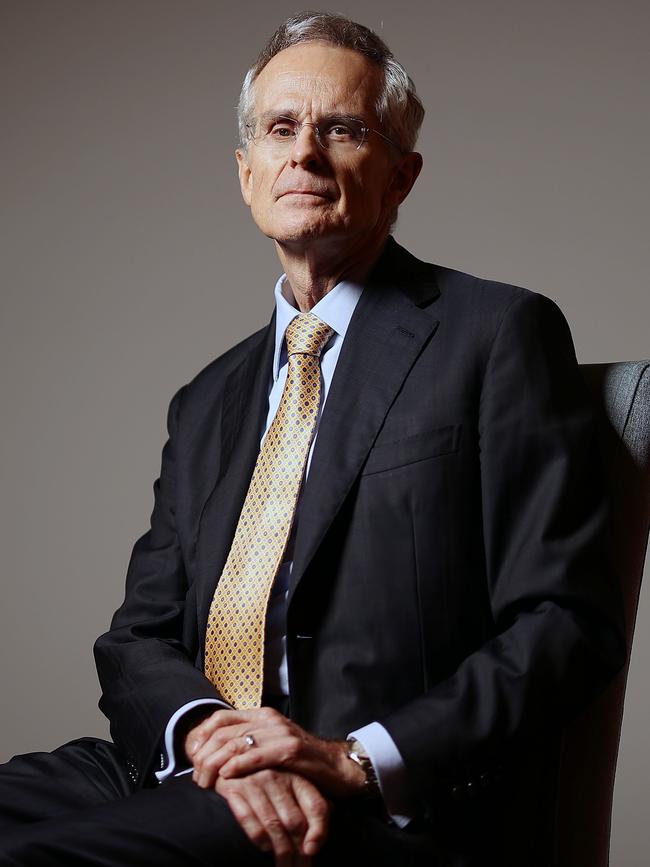Competition threat looms for Mike Cannon-Brookes, Brookfield’s $8bn AGL Energy bid as ACCC flags potential issues
The competition regulator’s chairman Rod Sims has warned of potential issues for a takeover of AGL Energy by Mike Cannon-Brookes and Brookfield.

An $8bn takeover bid for AGL Energy by Mike Cannon-Brookes and Brookfield could face a range of hurdles given the Canadian company’s ownership of Victoria’s electricity transmission operator AusNet, competition tsar Rod Sims has warned.
Receiving competition clearances has emerged as an early issue for the investment consortium, whose initial $7.50-a-share bid was rebuffed by the power giant, given big generators such as AGL have not traditionally been permitted to own electricity distribution and transmission companies.
Brookfield, funding 80 per cent of the offer, took control of AusNet in January as part of a $18bn takeover that gave it control of several Victorian energy networks, including two electricity grids and a gas distribution system.
Australian Competition & Consumer Commission chairman Mr Sims said although the regulator had not spoken with the consortium, the potential combination of assets could stoke concerns.
“The issue for us is going to be the fact that Brookfield owns AusNet and AusNet owns the transmission system in Victoria. And AGL, of course, owns important generation assets in Victoria and may well build others,” Mr Sims told The Australian.
“So the question is will Brookfield have any incentive? Yes it will, but more importantly, will it have the ability to favour its own generators through owning the transmission. That’s the question and it’s a very, very open question.”

UBS has already indicated competition clearances present an additional hurdle for the consortium, arguing there was no precedent for Australian regulators allowing vertically integrated private ownership across all four components of the electricity supply chain.
Mr Sims pointed out that no combination of generation and transmission had taken place since the national electricity market, or NEM, was created in 1998.
“There’s no precedent for combining generation and transmission. That’s the issue,” Mr Sims said. That hasn’t been done before ever since the NEM. So the NEM came along and broke all that up. No transmission company has owned generation and no generator has owned transmission. So it would be unique.”
Mr Sims noted the Australian Energy Market Operator was responsible for the planning and any expansions of the Victorian transmission network, a unique role that does not apply to other states in the NEM.
Understanding that relationship and its implications would also play a part.
“The market operator has a say in what gets built in transmission in Victoria. It doesn’t in NSW and Queensland and South Australia. So this would be much more of an issue in the other states. So in Victoria we just need to understand who does what to find out how big a problem this could be,” Mr Sims said.
“It could be a little problem. It could be a big problem. My summary on that is certainly something for us to look at. How big an issue it is, we just don’t know at this stage.
“If it would be allowed, Victoria is the place where it would be because of those unique arrangements. So that’s what we need to get to the bottom of and that’s why there’s no simple answer on this one.”
Still, the ACCC said the fact transmission was regulated would play a minor part in any assessments. “It’s not as if they go to favour their own generation by price,” Mr Sims said.
“It’s what you build, how you maintain it, all that sort of stuff, because generators only get dispatched if there’s transmission operational that is not being congested.”
Shareholders in the 180-year-old electricity company are due to vote in June on a plan to split it into two companies, a green retailer named AGL Australia seeking to be fully carbon neutral by 2040, and a coal-dominated generator, Accel Energy, targeting net zero emissions by 2047.
Morningstar has tipped the retail-focused AGL Australia will be an attractive takeover target after the split takes place, with Ampol, Shell, Total, Enel and Iberdrola all potential suitors.
AGL told The Australian on Tuesday the consortium would need to boost its takeover bid by at least another $1bn to be taken seriously, with CEO Graeme Hunt labelling its early coal retirement plan unfeasible.
An extra hurdle also looms with the Morrison government likely to stage an intervention if Mr Cannon-Brookes wins control of AGL and shuts coal by 2030, brokers have cautioned.
The tech billionaire lobbed a buyout offer valuing AGL at $5bn, or $8bn including debt, which was swiftly rejected for undervaluing the company.
The all-cash takeover tilt was pitched 5 per cent higher than AGL’s closing share price on February 18, but the power giant’s boss said takeover bids needed to be at a 30-40 per cent premium to get serious traction in the market.
That would imply adding at least an extra $1bn to its offer.
Shares in AGL fell 0.5 per cent to $7.65 on Wednesday.

